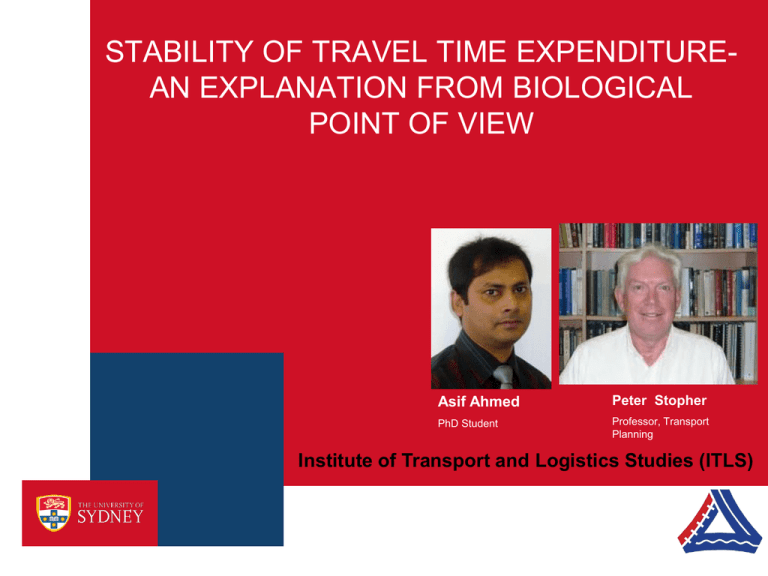UNIS Template - 15th TRB National Transportation Planning
advertisement

STABILITY OF TRAVEL TIME EXPENDITUREAN EXPLANATION FROM BIOLOGICAL POINT OF VIEW Asif Ahmed Peter Stopher PhD Student Professor, Transport Planning Institute of Transport and Logistics Studies (ITLS) Background & Introduction › TTB refers to stable (1-1.5 hours per day) amount of time spent on travelling. National Travel Surveys, UK 1972/73 to 2005 Travel time budget, h/cap/d › Invariant with space and time * Open circle uses most accurate CATTI & Travel Diary Daily distance travelled, km/cap/d › No analytical evidence found to answer why such stability? Source: Schafer, A. 2000, "Regularities in Travel Demand: An International Perspective", J. Transportation Statistics, vol.3, no. 3, pp. 1-31. 2 Biological Basis for Stability The concept of energy expenditure (MET) is described as the “…biological basis of physical activity…” It implies “…an inherent control centre within the central nervous system that regulates one’s daily energy expenditure with motor activity…” and, like other biological regulators, such “…an intrinsic activity centre should be expected to regulate the amount of daily physical activity to a particular set level…” (Rowland, 1998). “…both human and animal studies indicate that SPA, and the resultant energy expenditure (NEAT) are inherent…” and, “biologically regulated” (Garland et al., 2011). 3 Data & Method •South Australian Panel 50 hh, 4-weeks Personalised GPS travel survey in two waves in July and November 2005 •Data are cleaned using extensive manual map editing and software tools •Processed GPS travel data then used to identify travel mode by using the “mode detection software” developed by ITLS. •Energy Expenditure on travel is then estimated by using the travel time data (collected by GPS device) and mode specific energy expenditure coefficient. Data from GPS Device TI processing EE (KJ/m) Car, roads 4.2 Car2 13.4 Walk 14.1 Cycling 14.7 Standing r/h 6.7 Sitting 1.5 standing 2.6 Map Editing Post Map Editing •Research if any stability in energy expenditure on travel is obtained •Analyse the relationship between Energy Expenditure and Travel Time at an individual level Activity1 Cleaned Data 1Measured average values of energy consumption per unit time for different kinds of activities.(Source: Kolbl and Helbing, 2003 pp 48.4) 2Car travel in peak hour 4 Thank You Q & A? Email : A.Ahmed@itls.usyd.edu.au References Metz, D. 2008, "The Myth of Travel Time Saving", Transport Reviews, vol.28, no. 3, pp. 321336. Ausubel J H and Marchetti C (2001) “The Evolution of Transport”, The Industrial Physicist7(2): 20-24 Schafer, A. 2000, "Regularities in Travel Demand: An International Perspective", Journal of Transportation Statistics, vol.3, no. 3, pp. 1-31. Rowland, T. W. 1998, "The biological basis of physical activity", Medicine & Science in Sports & Exercise, vol.30, no. 3, pp. 392-399. Garland, T., Schutz, H., Chappell, M. A., Keeney, B. K., Meek, T. H., Copes, L. E., Acosta, W., Drenowatz, C., Maciel, R. C., van Dijk, G., Kotz, C. M. and Eisenmann, J. C. 2011, "The biological control of voluntary exercise, spontaneous physical activity and daily energy expenditure in relation to obesity: human and rodent perspectives", Journal of Experimental Biology Journal of Experimental Biology, vol.214, no. 2, pp. 206-229. Wilkin TJ (2011) “Pediatric Debate: Can we modulate physical activity in children? No”, International Journal of Obesity, 35,1270-1276. Kolbl, R. and Helbing, D. 2003, "Energy laws in human travel behaviour", New Journal of Physics, vol.5, no. 48.1–48.12.






